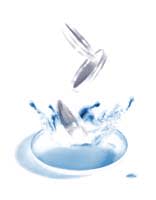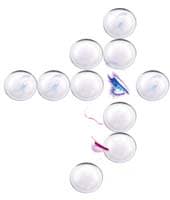|
|
|
SPECTACLE LENSES
A Look At Labs
There�s a struggle for dominance out
there. Who will have the foresight to survive?
By Joseph L. Bruneni
Photography by Peter Baker
Three years ago, the first of several industry events occured that had an almost seismic impact on laboratories and lens producers. The long-term effects of those events are expected in time to strongly impact the entire eyecare industry.
This first time, in-depth analysis of these industry changes will explore and explain the various aspects of how such changes may come to impact the retail eyecare professions.
Distribution of optical goods in this country is different than how eyeglasses are distributed in many other countries. Here, ophthalmic lenses are distributed through a three-tiered distribution channel. Lens manufacturers produce lenses and sell them in either finished or semi-finished form to laboratories or stock houses. Labs process the lenses and sell finished products to the professions. Stock houses sell stock lenses to retailers with in-office edging labs. Retail chains that buy direct from manufacturers and, for the most part, have their own processing laboratories. In other countries, however, larger lens manufacturers own and operate their own labs, selling finished products direct to retailers.
Differences between the United States and the rest of the world are fading, however. Three years ago, Essilor, the world�s largest optical manufacturer, began buying large independent laboratories in the United States. Two years later, Hoya, the next largest manufacturer, also started acquiring labs here.
|
|
|
|
|
|
Manufacturer-Owned Labs
Today, Essilor operates more than 70 laboratories in the United States, all of them previously independently owned. Hoya currently owns and operates 15 labs in this country.
Labs have influence with their customers and play a vital role in launching new lens products. One assumption is that factory-owned labs will ultimately concentrate on promoting primarily their own lenses. With many of the bigger, more influential labs no longer independent, there is widespread changing of alliances and partnerships between lens manufacturers and the remaining independent labs.
Here�s what the two major players as well as other lens casters who sell directly to labs have to say about the shifting market.
� Essilor Labs. Essilor is the dominant player, but Chris Paddison, president of Essilor Labs of America (ELOA), believes that contrary to popular belief, the market share of Hoya and Essilor labs is small compared to the entire U.S. lab industry.
�Essilor has acquired 16 laboratory companies, and these added to those purchased by Hoya haven�t made a dent in the number of independent lab operators in this country,� he points out. �As we�ve acquired labs, they still provide whatever lenses their customers want, whether it�s Essilor or any other product the lab has been carrying. Our strategy is to continue providing the doctor with the same range of products available to them before the acquisition.
�If you look at the development of premium lenses in this country compared to the rest of the world,� adds Paddison, �the U.S. is significantly behind other countries. This is true of AR coatings, progressives, and high index. Essilor�s intent is to get closer to labs because it takes labs and manufacturers working together to educate and support eyecare practitioners in premium lens products. And, we believe branded products are important ingredients for growing the market.�
Talking about its expanding programs designed to work with other key labs, Paddison says, �Essilor is committed to growing its base of Varilux distributors, and that is not vertical integration. We�re in a customer service game, and labs that provide the best service will win.�
� Hoya Labs. Hoya became the second lens manufacturer to acquire labs in the United States. This was accomplished by purchasing a group of independent labs that had merged into a company called Optical Resources Group. ORG labs represented 14 of the country�s larger and more successful laboratories, scattered around the country. Following the announcement of Hoya�s acquisition of ORG labs, each of the labs� Varilux (Essilor) contracts was cancelled. This was the first direct clash between Essilor and Hoya in the rearranged lab arena.
One year later, Hoya operates 15 laboratories here. These include 14 acquired labs from Optical Resources plus a company-built lab in Connecticut. Bill Norwood, executive vice president for Hoya�s Vision Care North America Headquarters, believes that vertical integration will make it easier for multinational corporations like Hoya to bring advanced technologies to this country. �Lenses, coatings, and frame designs are usually conceived as separate elements. Now sophisticated manufacturers can conceive of these elements as individual parts of an integrated system and produce a superior finished product,� he explains.
Hoya also believes that digital technology is driving a new manufacturing process in which prescriptions can be cut onto a blank with computer-controlled precision. Its view on consolidation is that it will provide higher quality products to consumers and that their enhanced in-office resources enables Hoya labs to provide dispensers with management technology and support programs.
|
|
|
Other Lens Producers
It�s estimated that labs currently owned by Essilor and Hoya represent some 40 percent of the total lab marketplace. Most acquired labs still process and sell whatever lenses their customers order. As might be expected, other lens producers are closely watching independent labs. Here is how some of these lens producers who sell their products directly to labs view the current situation.
� Younger Optics. President David Rips believes Younger is in a unique position. �As long as we continue to produce innovative new products like NuPolar and Trilogy and teach the market about their advantages, most labs will want to carry them. That should assure our continued success.�
� Sola Optical. Vice President Matt Cevasco explains, �Sola believes strongly that they need to have a strategy to attack this marketplace. Given the fact that Hoya and Essilor have chosen to acquire labs and Sola is determined not to get into the lab business, we have alternative plans to address this situation. It�s clear to us that the industry will see changes in how lenses are processed. We foresee technologies that require highly complex equipment that basically can produce a progressive lens from a block of material.�
Asked what he sees in the future for independent labs, Cevasco adds, �Independent labs will have to determine which products they want to support. Sola can�t determine distribution on a broad shotgun approach as in the old style business model. We are implementing a program to support independent laboratories much more aggressively than in the past. That�s key to our strategy.�
� Vision-Ease. Vice President Rich Montag explains their view of the market. �We�ve studied the dynamics taking place in the lab industry and have plotted the future landscape of processing laboratories�what it will look like, how many will be independent, and how many will be integrated with a lens manufacturer. Based on this, we�ve segmented our sales department into retail and wholesale segments. Getting our products to the dispenser is more complex because part of the distribution channel is in the hands of companies that also produce lenses. You�ll see us in a more concentrated effort to work with select independent laboratories who can make certain commitments. We are a product-driven company so we have selected niche products that provide premium lenses that non-integrated labs need in order to differentiate themselves.�
� Signet Armorlite. President Bruno Crissimi believes the current market changes, in some ways, reflect what is happening in Europe and Asia. �Signet has no plans to invest in labs. I do see a possibility that some labs may adapt a strategy of joining together to develop technology or brand names to differentiate their labs. This might be done through lab buying groups to help members compete with big labs.� Asked what he sees for independent labs, Crissimi said, �Medium to small labs that don�t understand that technology and brands are moving the market now will face difficulties in the future.�
� Rodenstock. In a recent meeting of the California Optical Laboratories Association (COLA), Rodenstock President Jim Cox assured COLA members that Rodenstock had no plans to acquire laboratories. He emphasized that informing and educating the eyecare professions regarding new lens technology was important and Rodenstock was expanding its retail sales force with this in mind. �We prefer not selling direct to retailers as long as there are local area labs offering our products,� he told the lab owners. �If there is an area where we get no support from local labs, however, we will sell direct.�
As for the future of independent labs, he adds, �Labs that used to consider themselves a general store, carrying every available lens product, will start carrying and promoting more specific products than they have in the past.�
� Pentax Vision, Inc. According to President Mike Jacobsen, �With fewer independent labs left, frankly, we have been able to dedicate more resources and marketing dollars to those that are left.�
In regard to the future for independent labs, he says, �Good independent labs will succeed for the simple reason they are selling to eyecare professionals who are (also) small business people.�
� Carl Zeiss. President Ed Greene explains the Zeiss strategy. �Our entire focus is on the private practitioner, and the laboratory is our root. We provide technology so labs can provide our brand to the retailer. Doing this requires cutting-edge equipment. This is the only market in the world that allows anyone other than Zeiss-owned facilities to make Zeiss products. It started with AR coatings, and we have now taken the next step with surfacing technology. Within a year, we will provide front curve technology by computer to our partner labs so they can make individualized Zeiss progressives. This represents the future.�
Regarding the future for labs, Greene comments, �I think the medium to smaller labs may be stronger in the future than bigger ones, but they�re going to have to find different technology to do it.�
|
|
|
|
|
|
What Lab Groups Say
Optical Laboratories Association. Known today as OLA, the group was called Association of Independent Optical Wholesalers (AIOW) 40 years ago. Factory-owned labs such as American Optical and Bausch & Lomb could not join. With factory-owned labs once again in the picture, however, the OLA no longer restricts membership. In fact, it has recently expanded who could join to include doctor-owned labs.
Consolidation of Essilor and Hoya labs has been costly to the association. The parent companies maintain group membership for their labs, but don�t pay individual lab dues.
Current OLA President Jeff Kosh enjoys an unusual distinction. His lab, Kosh Ophthalmics, is now part of Essilor, but he has retired. This unique position provides him a broad perspective on the lab marketplace. �The OLA speaks for all labs,� Kosh explains. �Our membership is made up of independently owned labs and factory-owned labs, and we represent them all. There are certain problems that all labs face�OSHA concerns and FDA problems, as well as a number of other issues that affect all labs. If we look back in time, we see that there have always been changes in the lab end of the business. Associations like the OLA have to adapt to the times, and that is what is now happening.�
Other lab associations. Several smaller groups of labs have banded together, partly for buying and partly as a way of sharing marketing and training resources. One such group is Optical Synergies, consisting of optical companies with surfacing laboratories. Most members are wholesale, but the group includes some retail organizations.
President Bruce Brady says, �The future for independent labs is strong. This is still a personalized business, and the relationship smaller labs have with their customers is strong. Our association provides support so our members can compete with the big hitters while maintaining a personal relationship with their customers. Retailers like being able to call their lab and talk to the owner when they have a problem. That�s the strength of the independent lab.�
Looking Ahead
In business today, acquisitions and mergers are part of the landscape, and, in our industry, there are always rumors swirling. Though some what-ifs seem imponderable, who would have predicted a few years ago that a frame company would purchase a huge retail chain like LensCrafters?
That purchase brings us to another interesting aspect of the current lab situation�and one that is seldom discussed. As some retail chains grow stronger, lab networks like those of Essilor and Hoya may find competition in the future coming as much from retail chains as independent labs.
When the two giant lens manufacturers target eyewear consumers, they will be competing directly with retail chains. How that conflict will impact private practitioners remains to be seen.
Regardless, some lens manufacturers believe that new lab technology will totally change the role of labs. They are betting that the personal relationship independent labs have with their customers, when partnered with the right lens manufacturer, will give independents an edge over factory-owned labs.
The next 10 years are going to be interesting.







